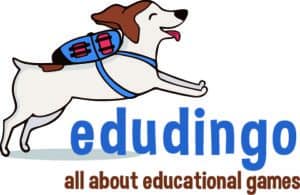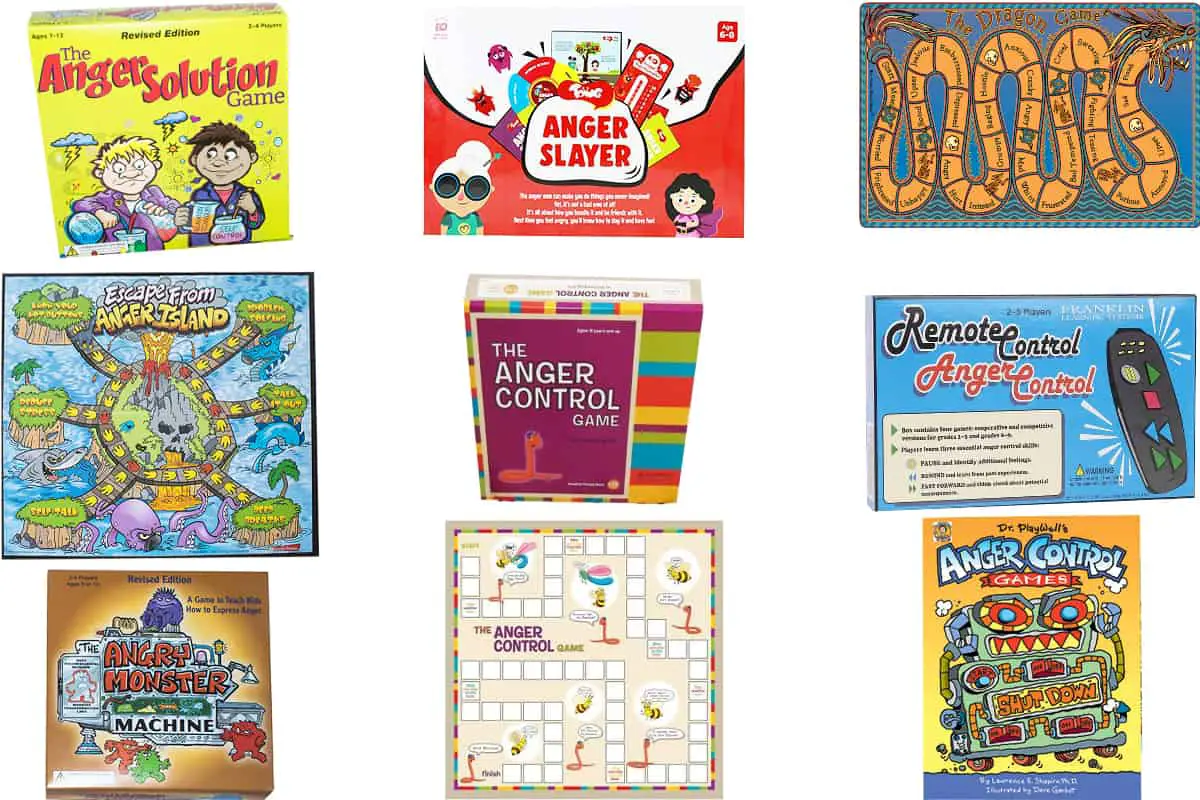This post contains affiliate links.
Lately, board games that are designed to manage anger issues have been on my radar. Many children and teens struggle with anger management and how to deal with anger in a positive way.
There are currently 25 anger management board games on the market, meant for children from Kindergarten to High School. Most are designed for schools (teachers or counselors), but some of them can be recommended for families as well.
The games that I recommend the most are Dr. Playwell’s Anger Control Game and The Dragon Game.
Anger Management Board Games Comparison Table
I am happy to recommend the following 10 anger management board games to help young people understand and manage their anger. To help you in picking out just the right game you can use the table below to compare the different games that are available.
| Game | Age | Players | Price | S | E | For | Rating |
|---|---|---|---|---|---|---|---|
| Anger Slayer | 5‑8 | 2‑4 | $$$ | X | X | F T C Th | ★★★★☆ |
| Dr. Playwell’s Anger Control Games | 5‑10 | 2‑4 | $$$$ | X | X | F T C Th | ★★★★☆ |
| Remote Control Anger Control | 5‑14 | 2‑5 | $$$ | X | X | F T C Th | ★★★★★ |
| The Dragon Game | 4-8 | 2‑4 | $$$$$ | X | X | T C Th | ★★★★☆ |
| Escape from Anger Island | 6‑11 | 2‑6 | $$$$ | X | X | Th C | ★★★★★ |
| The Anger Solution Game | 7‑12 | 2‑6 | $$$$ | X | Th C T | ★★★☆☆ | |
| The Anger Control Game | 8+ | 2+ | $$$$ | X | X | T C Th | ★★★★★ |
| Taming Your Dragon | 8-12 | 2‑4 | $$$$$ | X | X | T C Th | ★★★☆☆ |
| Anger Management Speedway | 11‑18 | 8‑12 | $$$$ | X | T C | ★★★☆☆ | |
| Anger Bingo for Teens | 12‑18 | 2‑16 | $$$ | X | X | F T C Th | ★★★★☆ |
Where “S“, “E” and “For” stand for the following:
- S: Teaches how to avoid situations that trigger anger
- E: Teaches how to express feelings appropriately
- For: F (Families) / T (Teachers) / C (Counselors) / Th (Therapists)
* “The Dragon Game” and “Taming Your Dragon” are sold together as a bundle
8 Anger Management Games for Kindergarten and Primary School
Anger Slayer (Toiing)
★★★★☆
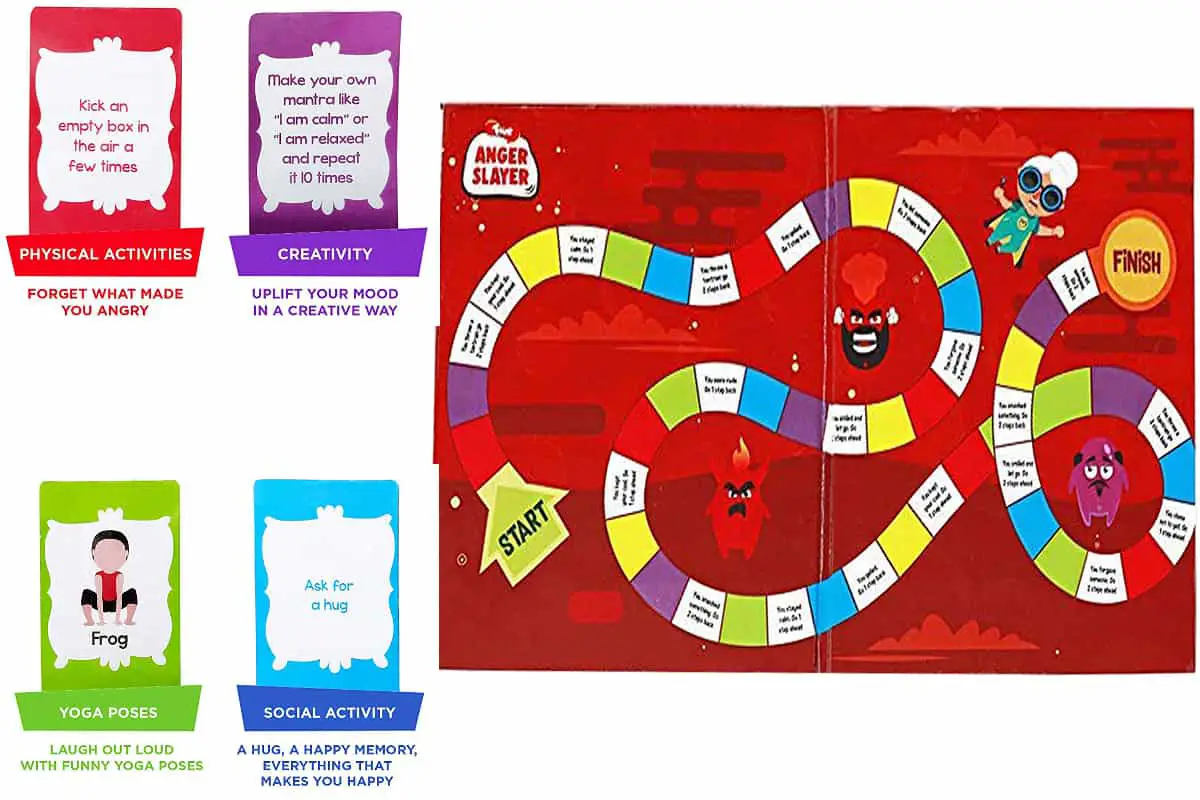
Players: 2-4 | Age: 5-8
Anger Slayer is a game where players learn to manage their feelings of anger and think through possible solutions when confronted with angry thoughts. I really like this game because it identifies that feelings of anger are not odd or strange, everyone gets angry and it is normal. Anger Slayer allows players to be aware of their anger as a normal emotion and then devise strategies for overcoming it.
is a game where players learn to manage their feelings of anger and think through possible solutions when confronted with angry thoughts. I really like this game because it identifies that feelings of anger are not odd or strange, everyone gets angry and it is normal. Anger Slayer allows players to be aware of their anger as a normal emotion and then devise strategies for overcoming it.
One benefit of Anger Slayer is that it is less expensive than other games on this list, making it more accessible to families. This game is fun for the whole family and playing it as a family can show players how different people respond to feelings of anger differently.
The game board and cards are fun and engaging making this perfect for younger players. The manufacturers recommend ages 5 and up but it is better suited for the younger end of the spectrum, 5-8 years old. Older kids might not find the game as engaging.
Dr. Playwell’s Anger Control Games (Childswork Childsplay)
★★★★☆
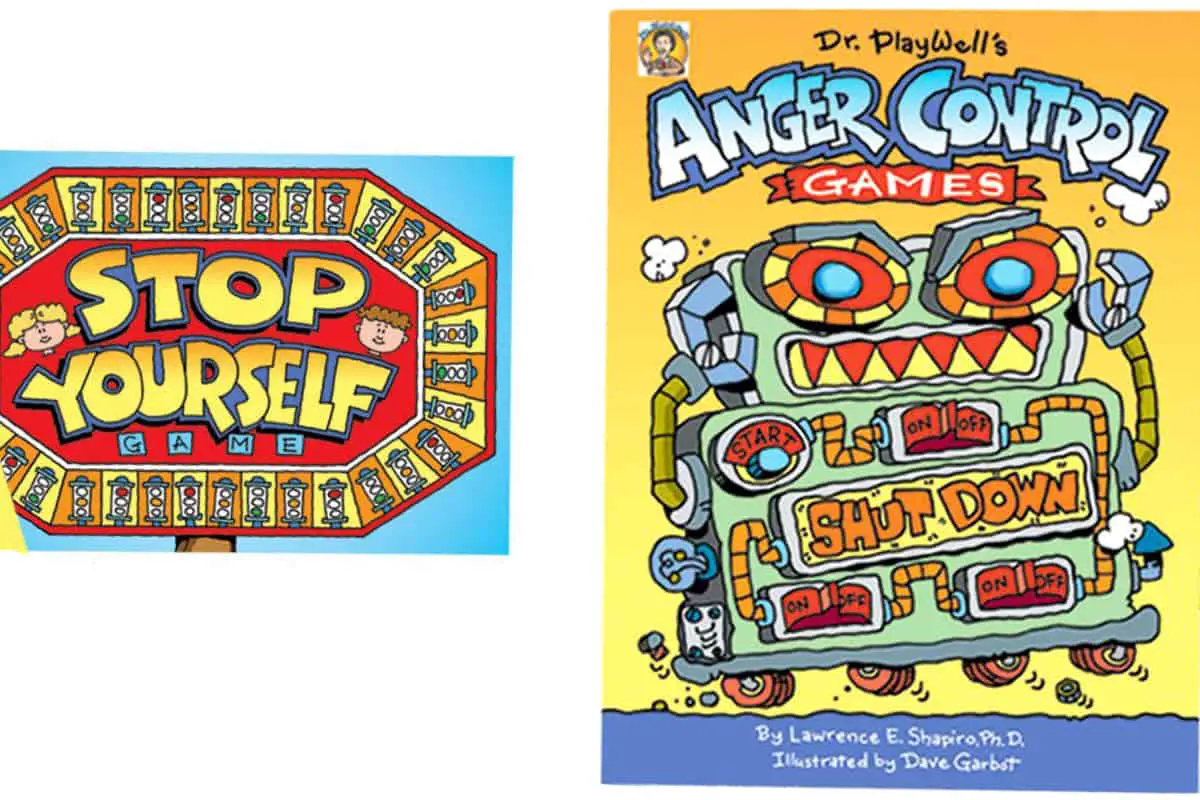
Players: 2-4 | Age: 5-10 | Author: Lawrence Shapiro
Dr. Playwell’s Anger Control Games set is a combination of 6 different games designed specifically for younger players that allow you to give students or children something different each time. The games included are:
set is a combination of 6 different games designed specifically for younger players that allow you to give students or children something different each time. The games included are:
- Creating Compromises — Teaches cooperation and problem-solving skills.
- Wheels of Feelings — Encourages students to use words to express anger and feelings rather than actions.
- Stop Yourself — Teaches how to slow and stop anger in the moment.
- Anger Buttons — Focuses on triggers of anger.
- Cool Down — Teaches relaxation techniques and strategies for calming down.
- Race for Responsibility — Includes lessons on behavior and positive values.
Dr. Playwell’s Anger Control games are portable and fun for 2-4 players. I highly recommend them for the classroom setting, especially a classroom where one of the main objectives is controlling anger. These games give flexibility and variety to meet a widespread of learner’s needs.
Remote Control Anger Control (Franklin Learning Systems)
★★★★★
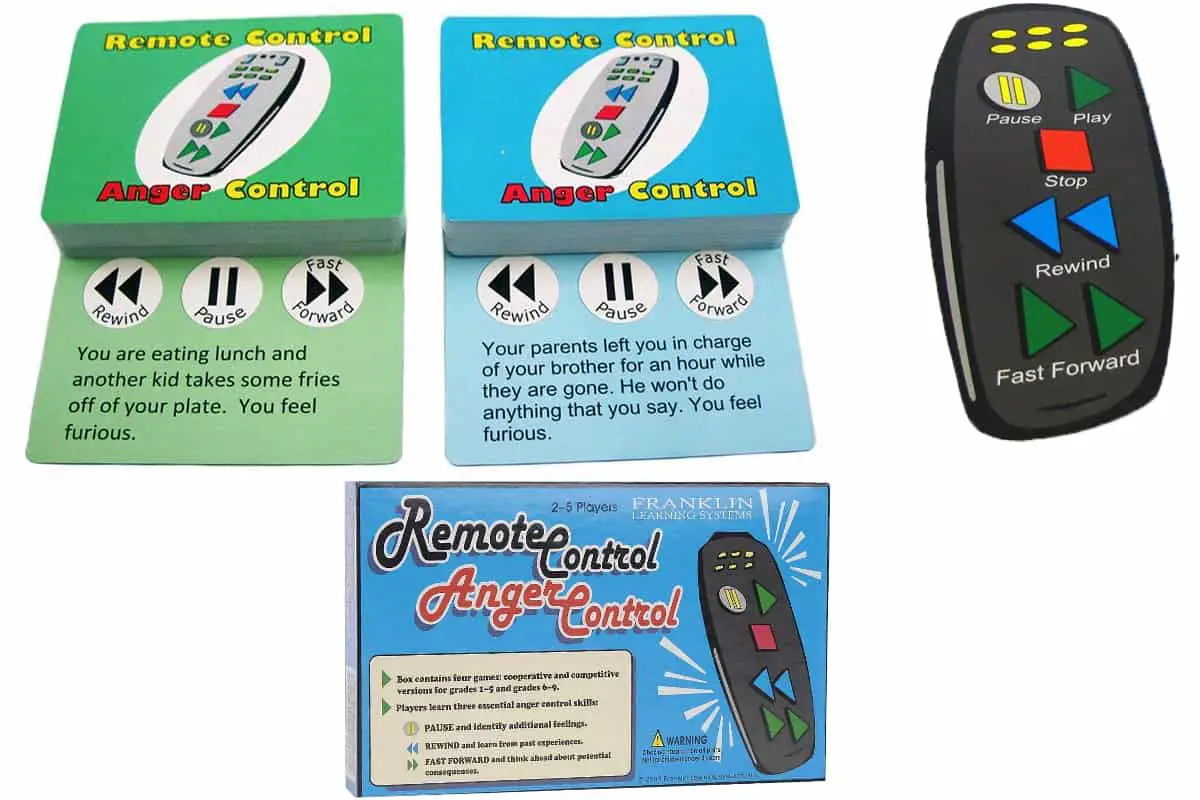
Players: 2-5 | Age: 5-14
Remote Control Anger Control is a unique game in that it allows for a very wide age range to play. The gameplay is simple, players have a remote control, they are given a scenario on a card and they are asked to respond to the situation. Players have a few options, can press PAUSE to describe a feeling they might have in that scenario, FAST FORWARD to predict how that scenario might play out in the future, or REWIND to describe a similar incident in the past.
is a unique game in that it allows for a very wide age range to play. The gameplay is simple, players have a remote control, they are given a scenario on a card and they are asked to respond to the situation. Players have a few options, can press PAUSE to describe a feeling they might have in that scenario, FAST FORWARD to predict how that scenario might play out in the future, or REWIND to describe a similar incident in the past.
One of the benefits of this game is that players must reflect on decisions that they have made and look forward to better ways of handling feelings of anger in the future. The game can be played by ages 5-14, there are two sets of cards, one for younger players (5-7), and one for older players (8-14).
Some of the benefits of the Remote-Control Anger Control game are:
- Self-reflection
- Identification of feelings
- Thinking through situations
- Impulse control
- Practice in controlling anger
The handheld remote is a major part of what makes this game engaging, especially for the younger players. It is interactive and fun, making learning about anger easy and entertaining.
The Dragon Game (Auxilium Horizons)
★★★★☆
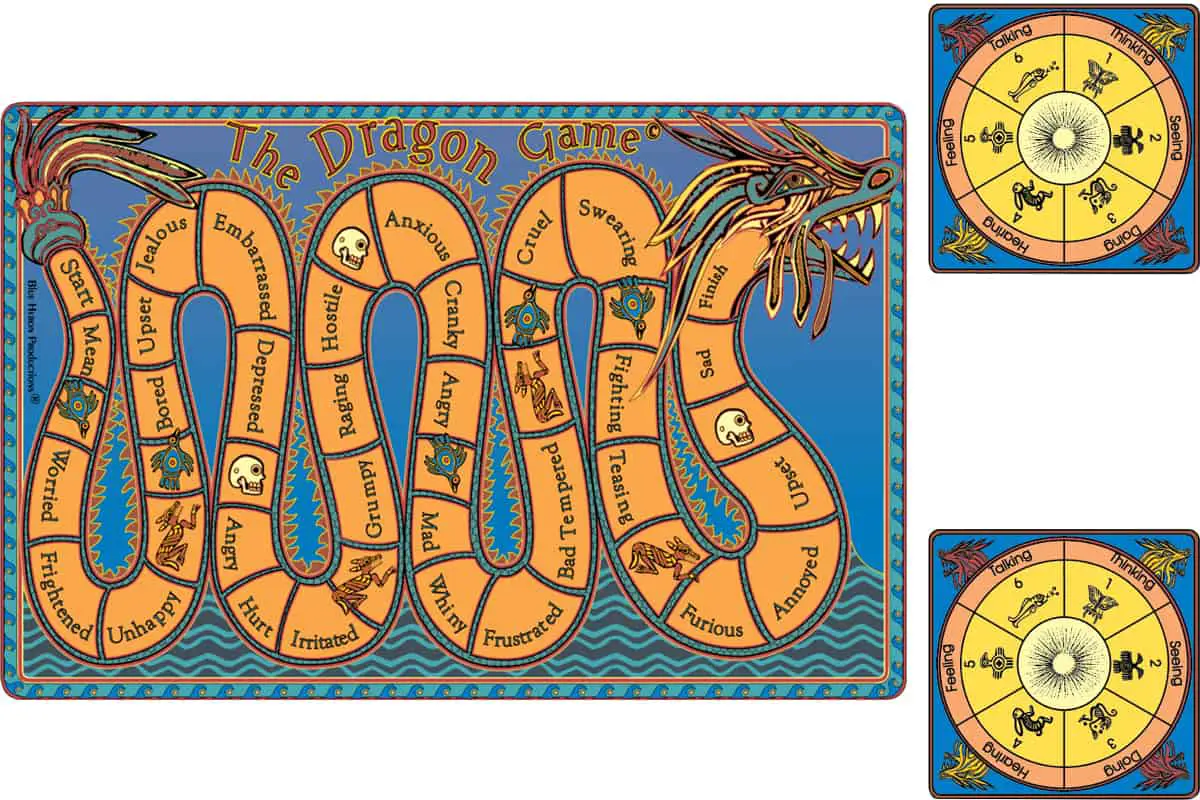
Players: 2-4 | Age: 4+
The Dragon Game comes in a 2 pack of games that includes Taming Your Dragon (reviewed below). One great aspect of this game is that it can be modified to be played with children as young as 4. It also is one of the most beautifully designed board games on this list with some really great artwork that helps make the game more fun and engaging. Players move around the board and discuss times where they were angry, frustrated, or other feeling other emotions associated with anger.
comes in a 2 pack of games that includes Taming Your Dragon (reviewed below). One great aspect of this game is that it can be modified to be played with children as young as 4. It also is one of the most beautifully designed board games on this list with some really great artwork that helps make the game more fun and engaging. Players move around the board and discuss times where they were angry, frustrated, or other feeling other emotions associated with anger.
A main reason for recommending The Dragon Game is that it also asks players to express times that other people have been angry with them. This change of perspective is very helpful in developing empathy, a key factor in mitigating angry reactions. It also asks players to identify warning signs of anger in others which can help the player to also recognize warning signs in themselves.
The game is intended for up to 4 players, but you could really play it with as many as you like, you will just need to share the game pieces or invent new ones.
Other Games
Monster Stomp (Players 2-4 | Age 4 and up) is an award-winning game that helps kids get control of emotions surrounding anger such as fear and anxiety. Similar to the Angry Monster Machine, players make a monster out of Playdoh that acts as a metaphor for pieces of anger in a child’s life. When players land on a Monster Stomp space they get to stomp out a monster. The adult then has an opportunity to stomp out what that monster represents in real life.
(Players 2-4 | Age 4 and up) is an award-winning game that helps kids get control of emotions surrounding anger such as fear and anxiety. Similar to the Angry Monster Machine, players make a monster out of Playdoh that acts as a metaphor for pieces of anger in a child’s life. When players land on a Monster Stomp space they get to stomp out a monster. The adult then has an opportunity to stomp out what that monster represents in real life.
Exploring My Anger (2-6 players | Age 5-12) is a game designed specifically with therapists in mind. The game is made to help the therapist determine how a child handles their anger. This game also has sentence completion cards, which is useful for therapists who have patients with limited English skills or who have a hard time expressing their thoughts. The main focus of Exploring My Anger is on allowing the child to reflect on past anger and choices and start paving a new path forward with new strategies.
(2-6 players | Age 5-12) is a game designed specifically with therapists in mind. The game is made to help the therapist determine how a child handles their anger. This game also has sentence completion cards, which is useful for therapists who have patients with limited English skills or who have a hard time expressing their thoughts. The main focus of Exploring My Anger is on allowing the child to reflect on past anger and choices and start paving a new path forward with new strategies.
The Angry Monster Machine (Players 2-4 | Age 5-10): Players learn coping skills as they play. As players move around the board the game asks players questions giving insight into root causes of anger in the child. The gameplay also allows players to learn verbalization skills to better express their anger. The most interesting part of this game is the game pieces, they are monsters that are made of Playdoh making this game highly engaging and fun, especially for the younger players.
(Players 2-4 | Age 5-10): Players learn coping skills as they play. As players move around the board the game asks players questions giving insight into root causes of anger in the child. The gameplay also allows players to learn verbalization skills to better express their anger. The most interesting part of this game is the game pieces, they are monsters that are made of Playdoh making this game highly engaging and fun, especially for the younger players.
Angry Animals 2 (Players 2-6 | Age 5-10) is the sequel to the popular Angry Animals board game. This game is just plain fun, especially for younger players because it has fun cartoon animals and game pieces. Communication is the main focus of this game. It teaches kids to communicate feelings of anger appropriately and how to handle their emotions when feeling angry. Angry Animals 2 might be too childish for the upper end of it’s suggested age range. I would recommend it for ages 5-8.
(Players 2-6 | Age 5-10) is the sequel to the popular Angry Animals board game. This game is just plain fun, especially for younger players because it has fun cartoon animals and game pieces. Communication is the main focus of this game. It teaches kids to communicate feelings of anger appropriately and how to handle their emotions when feeling angry. Angry Animals 2 might be too childish for the upper end of it’s suggested age range. I would recommend it for ages 5-8.
11 Anger Management Games for Primary School
Escape from Anger Island (Franklin Learning Systems)
★★★★★
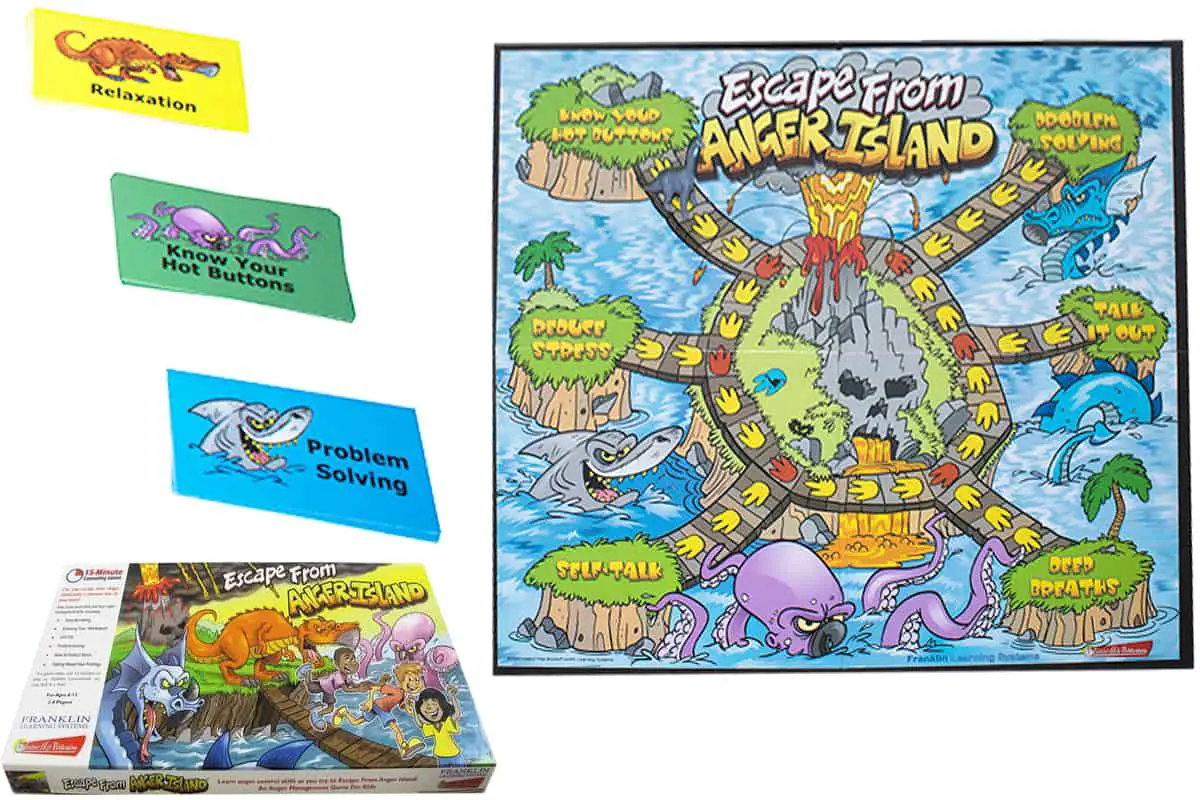
Players: 2-6 | Age: 6-11
Escape from Anger Island is a fast-paced game designed for counselors. The game can be played by an adult and a child or up to 5 children at a time. It can be played in roughly 15 minutes per child and focuses on six key anger management skills. These include:
is a fast-paced game designed for counselors. The game can be played by an adult and a child or up to 5 children at a time. It can be played in roughly 15 minutes per child and focuses on six key anger management skills. These include:
- Problem Solving
- Knowing your Hot Buttons
- Talking out Conflicts
- Reducing Stress
- Self-Talk
- Relaxation
The game specifically focuses on one of the above with each play session. This is great because it teaches and targets the concept that a child needs the most without overwhelming them with too much information. I highly recommend Escape from Anger Island to counselors and therapists.
The Anger Solution Game (Childswork Childsplay)
★★★☆☆
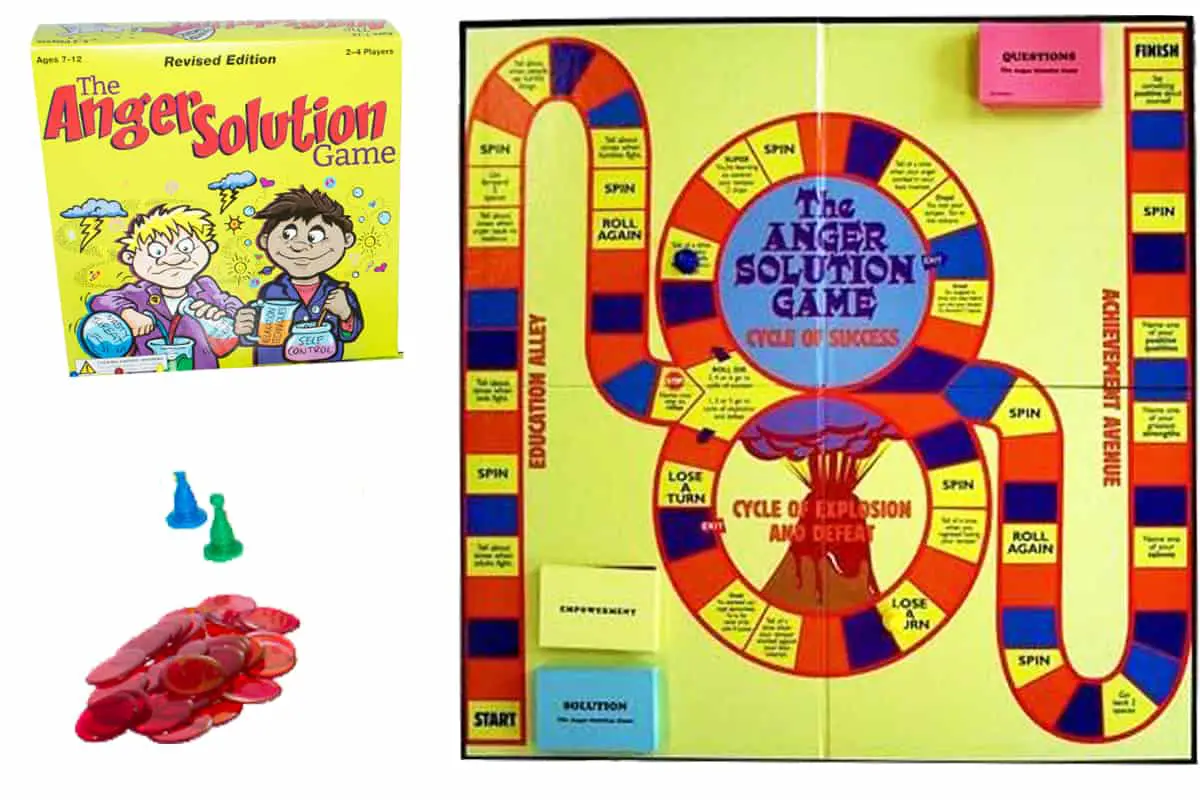
Players: 2-6 | Age: 7-12
The Anger Solution Game emphasizes choices that students make when they are angry. It emphasizes taking the “success route” over the “victim route” to help give students a sense of control over their anger rather than allowing their anger to control them.
emphasizes choices that students make when they are angry. It emphasizes taking the “success route” over the “victim route” to help give students a sense of control over their anger rather than allowing their anger to control them.
During gameplay, players are confronted with a number of decisions that they must make in order to prevail over their anger. This game is better suited for classroom play or play with a trained professional who can help students to reason out their decisions. This game is recommended because it gives students control over their choices and decisions, often this can be a difficult idea for children to grasp. The Anger Solution Game allows the child to learn to make good choices.
For teachers, counselors, or therapists, it might be beneficial to buy the full collection . It does cost $168.70, but it comes with a ton of extras like scripts, the Anger Solution Card Game, workbook, and even a fun inflatable “Keep Your Cool Ball.”
. It does cost $168.70, but it comes with a ton of extras like scripts, the Anger Solution Card Game, workbook, and even a fun inflatable “Keep Your Cool Ball.”
The Anger Control Game (Childswork Childsplay)
★★★★★
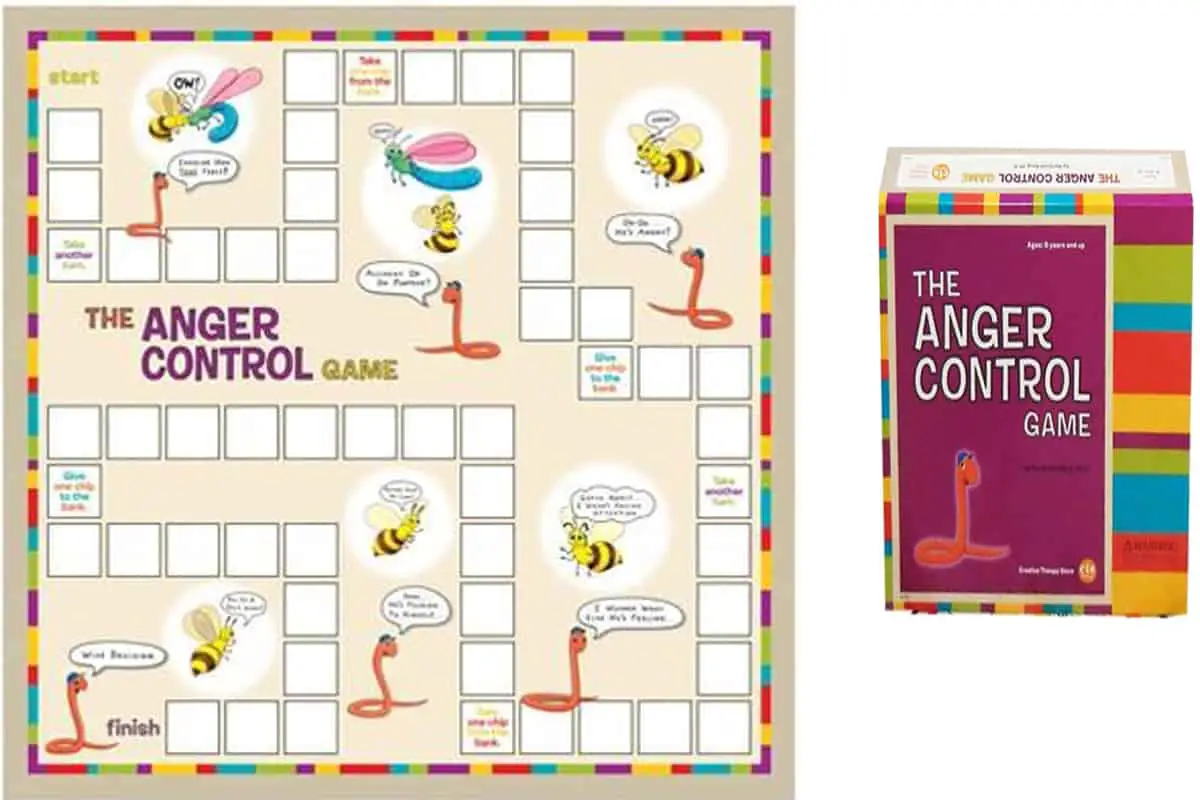
Players: 2 or more | Age: 8+ | Author: Berthold Berg
The Anger Control Game is a board game designed to teach children to manage and control their anger, especially children with conduct disorders or temper control issues.
is a board game designed to teach children to manage and control their anger, especially children with conduct disorders or temper control issues.
Of all of the games on this list, this one is perhaps the most scientifically based game of them all. It is rooted in teaching six essential skills for anger management:
- Developing empathy for victims
- Knowing the difference between aggression and nonaggression
- Using self-talk to diffuse anger
- Developing and choosing alternatives to aggression
- Identifying why we feel angry
- Determining and evaluating other’s opinions
One of the biggest bright sides for The Anger Control Game, for teachers, is that it comes with an “Anger Control Inventory.” This acts as a pre-test and helps to identify and teach skills in the areas that need to be developed.
The game can be complex for younger children, but the gameplay can be easily modified to make it shorter, easier, or more fun.
Taming Your Dragon (Auxilium Horizons)
★★★☆☆
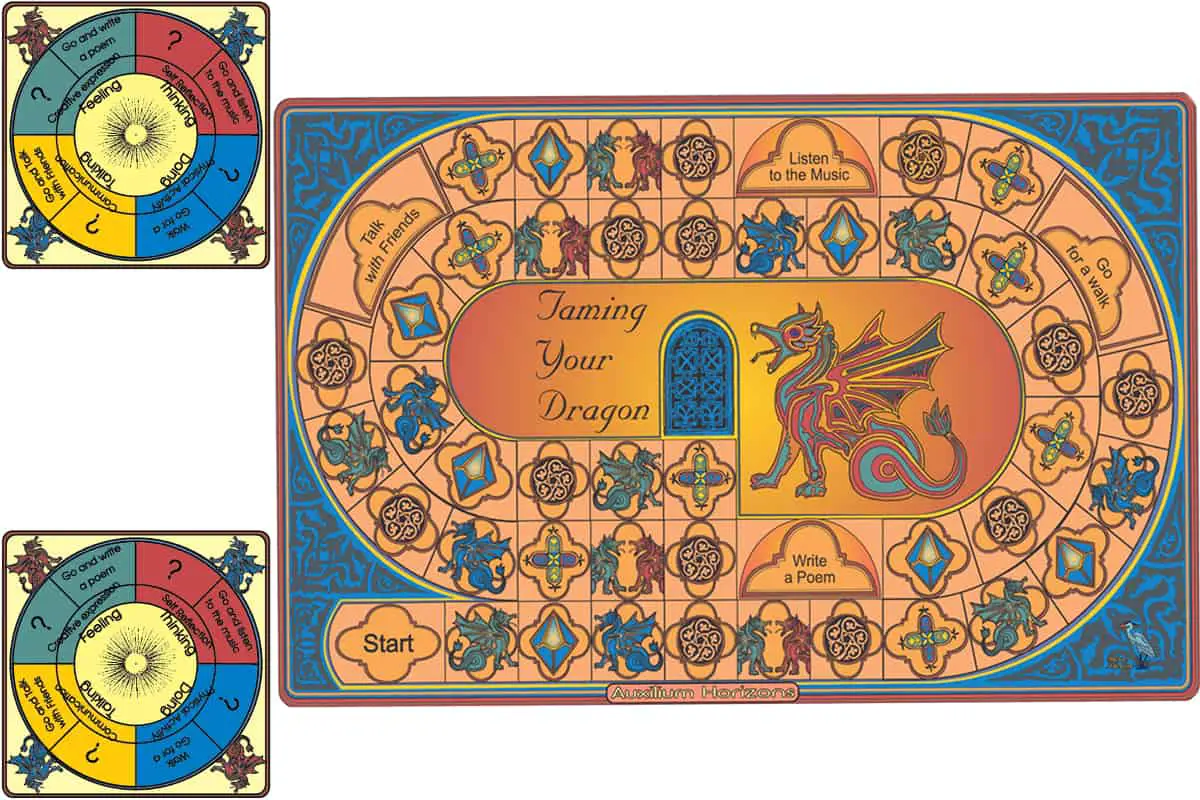
Players 2-4 | Age 8+
Similar to The Dragon Game (reviewed above), Taming your dragon has an exquisite game board. The game is very similar to The Dragon Game yet it does require a higher level of vocabulary in order for players to play the game. The beauty of this game is that it can be played with almost any age because the complexity is in the discussion, not the game itself.
has an exquisite game board. The game is very similar to The Dragon Game yet it does require a higher level of vocabulary in order for players to play the game. The beauty of this game is that it can be played with almost any age because the complexity is in the discussion, not the game itself.
To play, players use a spinner to travel around a board and discuss various anger-related feelings, situations, and emotions. It even has players reflect on places where they feel safe and comfortable. The objectives as stated in the rules are as follows:
- Increasing awareness of anger
- Exploring causes of anger
- Recognizing warning signs
- Personal storytelling and validation
- How does safety and feeling safe play a role
- Identify sources of one’s own anger
- Identify positive ways of expressing anger
- Creating strategies for managing anger
- Building self-esteem
Other Games
Robot Rage (Players 2-4 | Age 6-11) allows players to put themselves in a situation and describe how they would respond. They then get to move forward or backward depending on how they answer. This game is a hybrid board and card game and helps students understand that their choices have consequences, either positive or negative. It also presents alternative options to children who respond in anger the majority of the time. The game is designed for 2-4 players but it can also be done in small groups if needed. The focus of this game is on coping skills, self-reflection, and communication.
(Players 2-4 | Age 6-11) allows players to put themselves in a situation and describe how they would respond. They then get to move forward or backward depending on how they answer. This game is a hybrid board and card game and helps students understand that their choices have consequences, either positive or negative. It also presents alternative options to children who respond in anger the majority of the time. The game is designed for 2-4 players but it can also be done in small groups if needed. The focus of this game is on coping skills, self-reflection, and communication.
I Feel Angry When… (Players 2-6 | Age 6-12) is a great game for coaching students or players on how to respond verbally when they feel angry. Many times when a child is angry an adult will tell them “Use your words!” This only helps if the child has the ability to put their thoughts into words. That is the goal of I Feel Angry When…, players are asked to respond to situations using their words through an “I statement.” The game also works on 12 anger control strategies to help students get calmed down to the point where they can actually verbalize their anger.
(Players 2-6 | Age 6-12) is a great game for coaching students or players on how to respond verbally when they feel angry. Many times when a child is angry an adult will tell them “Use your words!” This only helps if the child has the ability to put their thoughts into words. That is the goal of I Feel Angry When…, players are asked to respond to situations using their words through an “I statement.” The game also works on 12 anger control strategies to help students get calmed down to the point where they can actually verbalize their anger.
Stop, Relax, and Think (Players: 2-6 | Age: 6-12) is different from other games on this list because it also can serve as a diagnostic tool to help the teacher understand a student’s anger. This game is designed specifically for counselors, special education providers, and therapists rather than for in-home use. Through gameplay, students go through strategies of identifying and stopping feelings of anger.
(Players: 2-6 | Age: 6-12) is different from other games on this list because it also can serve as a diagnostic tool to help the teacher understand a student’s anger. This game is designed specifically for counselors, special education providers, and therapists rather than for in-home use. Through gameplay, students go through strategies of identifying and stopping feelings of anger.
Smart and Angry (Players 2-6 | Age 7-11) recognizes that anger is only an emotion, an emotion that every person encounters. The game understands that it is people’s reactions to anger that get them in trouble, not simply the fact that they are angry. Through gameplay, players learn to make good decisions and how to control their feelings of anger and handle them in a positive way.
(Players 2-6 | Age 7-11) recognizes that anger is only an emotion, an emotion that every person encounters. The game understands that it is people’s reactions to anger that get them in trouble, not simply the fact that they are angry. Through gameplay, players learn to make good decisions and how to control their feelings of anger and handle them in a positive way.
Furious Fred (Players 2-6 | Age 7-12) is a fun game where players move around a game board and attempt to help Fred deal with difficult situations. When they are confronted with a situation they must give Fred advice, depending on the quality of their advice they earn points, which are on printed paper slips and resemble money. Furious Fred helps players identify situations that might make them angry and make a plan for how they will react. The main premise for this game’s success is that it reduces the anxiety around confronting your own anger, instead players are just giving free advice to Fred.
(Players 2-6 | Age 7-12) is a fun game where players move around a game board and attempt to help Fred deal with difficult situations. When they are confronted with a situation they must give Fred advice, depending on the quality of their advice they earn points, which are on printed paper slips and resemble money. Furious Fred helps players identify situations that might make them angry and make a plan for how they will react. The main premise for this game’s success is that it reduces the anxiety around confronting your own anger, instead players are just giving free advice to Fred.
Anger Alert! (Players 2-4 | Age 7-12) is designed to both teach and practice strategies for reducing anger in a variety of situations. Players answer questions on cards but must wait for an hourglass to run out before answering. This helps ensure all players get to give a thoughtful answer. A big focus of Anger Alert! is on noticing signs of anger in themselves so that they can begin to defuse their anger. This is a fun game and can be played in small groups.
(Players 2-4 | Age 7-12) is designed to both teach and practice strategies for reducing anger in a variety of situations. Players answer questions on cards but must wait for an hourglass to run out before answering. This helps ensure all players get to give a thoughtful answer. A big focus of Anger Alert! is on noticing signs of anger in themselves so that they can begin to defuse their anger. This is a fun game and can be played in small groups.
Anger Defuser (Players: 2-6 | Age 8-18) is modeled off of Clue both in gameplay and board layout. Players try to determine who diffused anger, in what location, using which technique. Anger Defuser is good for students to review their knowledge of different coping skills and techniques. It is also a fun way for students to practice interacting with one another in a positive way.
(Players: 2-6 | Age 8-18) is modeled off of Clue both in gameplay and board layout. Players try to determine who diffused anger, in what location, using which technique. Anger Defuser is good for students to review their knowledge of different coping skills and techniques. It is also a fun way for students to practice interacting with one another in a positive way.
6 Anger Management Games for Middle School and Up
Anger Management Speedway (Wellness Reproductions)
★★★☆☆
Players: 8-12 | Age: 11-18 | Author: Rhonda Godwind
Anger Management Speedway is a game with older children and teens in mind. This is very helpful due to the fact that many of the other games on this list are catered towards a younger audience. In Anger Management Speedway the players race around the board as they learn different aspects of anger management.
is a game with older children and teens in mind. This is very helpful due to the fact that many of the other games on this list are catered towards a younger audience. In Anger Management Speedway the players race around the board as they learn different aspects of anger management.
While playing Anger Management Speedway players learn to identify how anger affects their health, how to manage and cope with anger, and general awareness of anger. These three pillars are why I recommend this game. It really can help older students and children to not just control their anger but also to identify situations in which they may be likely to feel angry.
A possible negative to Anger Management Speedway is that it doesn’t look like it is made for teens and adults. It is a bit childish in its presentation, this may be good for the 11-13 range but might not be great for 14 and up. Don’t be fooled though, the content is geared towards the older students too, just not the appearance.
Anger Bingo for Teens (Wellness Reproductions)
★★★★☆
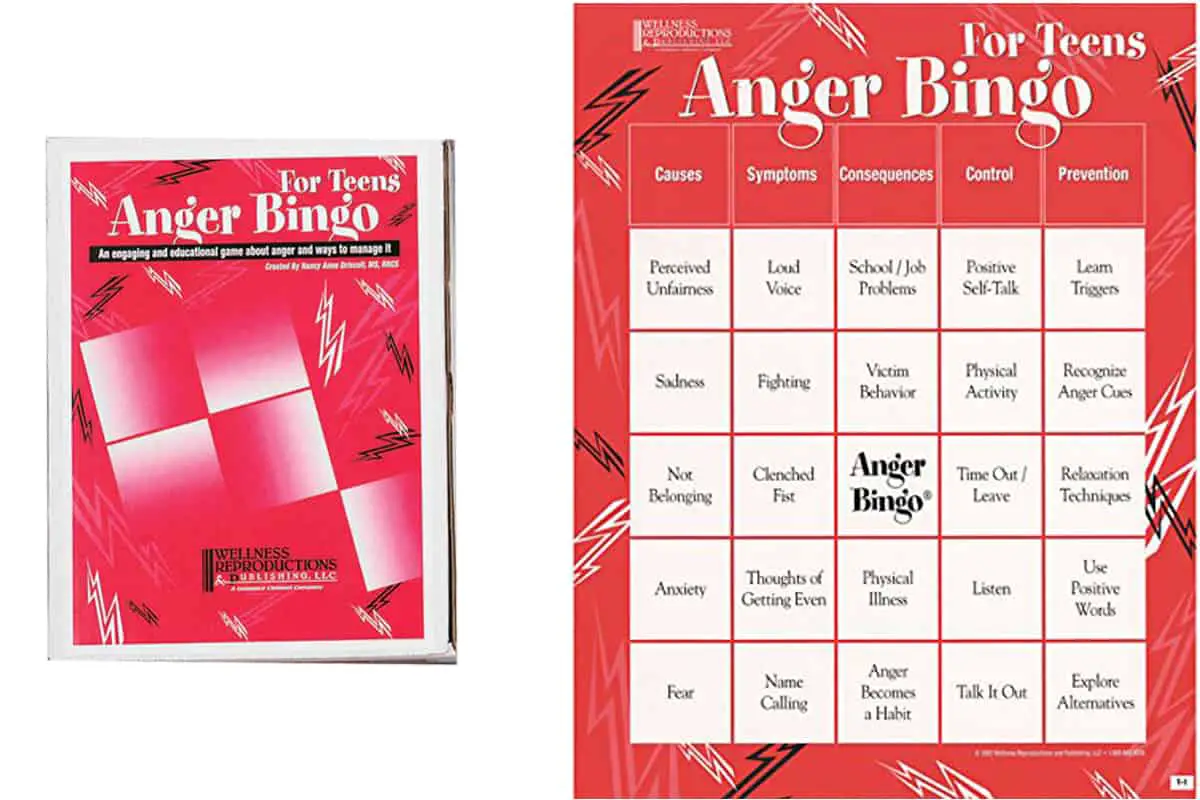
Players: 2-16 | Age: 12-18
Everyone loves a good game of BINGO, this version comes with a twist, it is designed to help identify anger and coping mechanisms. Anger BINGO for Teens is super flexible, allowing anywhere from 2-16 players, you could also divide players into groups and allow them to play that way. This would allow this game to also be used in a larger class environment. Many games cannot be played with this many people, this is why I recommend this game for teachers or anyone working with larger groups. Although it can be used with two people just as effectively.
is super flexible, allowing anywhere from 2-16 players, you could also divide players into groups and allow them to play that way. This would allow this game to also be used in a larger class environment. Many games cannot be played with this many people, this is why I recommend this game for teachers or anyone working with larger groups. Although it can be used with two people just as effectively.
Anger BINGO for Teens is also very useful because it allows for further discussion during the game. Sometimes games can be too focused on style and not focused enough on substance. This game does both very well. It is simple, yet kids love to play it.
The game teaches kids the following:
- Preventing anger
- Controlling anger
- Identifying triggers
- Diagnosing symptoms
Other Games
Think it Through Anger Game (Players 2 or more / Ages 10-14) is a thinking game in which players are asked to consider situations in which they have been angry and how they dealt with their anger. Players may land on a Solve It! square where they are required to discuss the situation and how to best respond to it. Think it Through Anger Game is also very good at identifying and teaching various triggers to anger such as Sadness, Frustration, Embarrassment, Jealousy, Hurt, Disappointment. Learning these triggers helps players learn to cope with and understand where their anger is coming from. This, in turn, can lead to players understanding how to prevent situations that may cause anger.
(Players 2 or more / Ages 10-14) is a thinking game in which players are asked to consider situations in which they have been angry and how they dealt with their anger. Players may land on a Solve It! square where they are required to discuss the situation and how to best respond to it. Think it Through Anger Game is also very good at identifying and teaching various triggers to anger such as Sadness, Frustration, Embarrassment, Jealousy, Hurt, Disappointment. Learning these triggers helps players learn to cope with and understand where their anger is coming from. This, in turn, can lead to players understanding how to prevent situations that may cause anger.
From Rage To Reason (Players 2-6 / Ages 13 to adults) is definitely worth a look if you are a counselor or teacher who works with children in the older age ranges. This game is recommended for players age 13 and up and as such has a more mature feel to it, unlike some games that can be played by older children but feel like little kid games. The main goals of the game are to control anger and avoid violence. From Rage to Reason promotes self-skills, thinking skills, and people skills as players give advice to Randy, a fictitious young person. Similar to Furious Fred, the players earn money as they give good advice. One major benefit for teachers is that there are complete lesson plans included in the game.
(Players 2-6 / Ages 13 to adults) is definitely worth a look if you are a counselor or teacher who works with children in the older age ranges. This game is recommended for players age 13 and up and as such has a more mature feel to it, unlike some games that can be played by older children but feel like little kid games. The main goals of the game are to control anger and avoid violence. From Rage to Reason promotes self-skills, thinking skills, and people skills as players give advice to Randy, a fictitious young person. Similar to Furious Fred, the players earn money as they give good advice. One major benefit for teachers is that there are complete lesson plans included in the game.
Anger IQ (Ages 14 and up) is a game that is designed for older students. This alone makes Anger IQ worth a look as it is one of the few games on this list specifically designed with older kids and young adults in mind. Some of the outcomes of Anger IQ are:
- Reduction of anger
- Decision making while angry
- Blame and avoiding blame placing
- Handling anger in a non-violent manner
This game definitely focuses on some higher-level research and information than games designed for younger players. I believe that this makes it more engaging and less kid-like for older users.
Endless Games Anger Management Party Game (Ages 14-15) is good for letting participants lighten up about their anger issues although it is not highly recommended for a couple of reasons. One, it is marketed towards 14-15-year olds but has some questions that might be considered inappropriate for this age range. Second, it can actually encourage anger in the participants as the winner is determined by whoever loses their cool first. This can be a fun party game or perhaps a game for adults but it isn’t really an anger management game for kids.
(Ages 14-15) is good for letting participants lighten up about their anger issues although it is not highly recommended for a couple of reasons. One, it is marketed towards 14-15-year olds but has some questions that might be considered inappropriate for this age range. Second, it can actually encourage anger in the participants as the winner is determined by whoever loses their cool first. This can be a fun party game or perhaps a game for adults but it isn’t really an anger management game for kids.
Other Types of Games for Anger Management:
In addition to board games, there are many other types of anger management games available for both classroom and home use. Anger management card games are another way to help students and children learn about and manage their anger.
are another way to help students and children learn about and manage their anger.
Conflict resolution can be related to anger management in school. Often, as a result of anger, students come in conflict with one another and need to resolve their conflicts. There are conflict resolution board games  and card or dice games
and card or dice games available to help in this area.
available to help in this area.
Edudingo.com is a participant in the Amazon Services LLC Associates Program, an affiliate advertising program designed to provide a means for sites to earn advertising fees by advertising and linking to Amazon.com. We also participate in other affiliate programs which compensate us for referring traffic.
